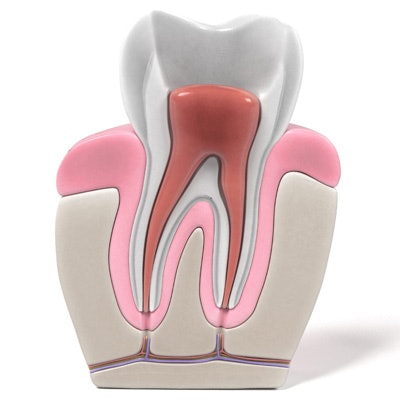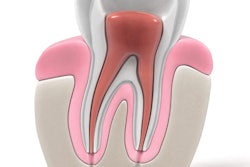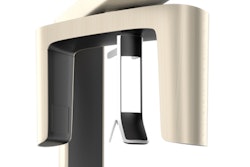
When looking for root fractures, conventional scanning methods may miss crucial clinical information. Researchers wanted to see if a fluorescence camera could measure the depth of these fractures and any bacterial presence in extracted mandibular second molars.
After scanning the root fractures using a fluorescence camera, they were successful in identifying root fractures and the presence of bacterial contamination, and the study authors reported their findings in the Journal of Dentistry (July 12, 2019).
The conventional method for diagnosing root fractures is to obtain magnified images using an operating microscope after staining with methylene blue dye. However, this method may have a low sensitivity for identifying dentine cracks, the authors wrote.
The researchers conducted an in vitro study using 33 previously extracted mandibular second molars with periapical lesions. These molars had been extracted after root fractures were discovered during intentional replantation or diagnostic surgery.
They scanned the root fractures using a fluorescence camera (QLF-D Biluminator 2+, Inspektor Research Systems) and a microcomputed tomography (micro-CT) system (Skyscan 1076, Bruker).
The researchers found 33 root fractures in the teeth, which were confirmed with micro-CT. Under illumination by blue-violet light, the root fractures appeared darker than the surrounding sound surface, they reported. In addition, a gradual increase in the quantitative fluorescence parameter indicated the deepest point in the fractures.
The red autofluorescence associated with bacteria was found in 57% of the root fractures. Bacteria were detected with fractures in more than 94% of the 19 teeth exhibiting red fluorescence (see table below).
| Percentage of bacteria found within fractures according to red fluorescence | ||
| Absence | Presence | |
| Red fluorescence | 5.3% | 94.7% |
| Nonred fluorescence | 71.4% | 28.6% |
The researchers listed one study limitation, which was that they excluded fractures with severe curvature in the axial plane because of the difficulty of detecting a severely curved fracture inside the root.
"This fluorescence technique could be applied in clinical practice for crack detection during surgical procedures such as diagnostic surgery or apical surgery," concluded the authors, led by Hye-min Ku, PhD, of the department of preventive dentistry and public oral health at the Yonsei University College of Dentistry in Seoul, South Korea.



















